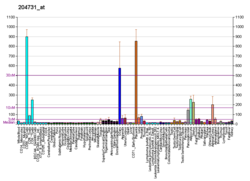Betaglycan also known as Transforming growth factor beta receptor III (TGFBR3), is a cell-surface chondroitin sulfate / heparan sulfate proteoglycan >300 kDa in molecular weight. Betaglycan binds to various members of the TGF-beta superfamily of ligands via its core protein, and bFGF via its heparan sulfate chains.[5][6] TGFBR3 is the most widely expressed type of TGF-beta receptor. Its affinity towards all individual isoforms of TGF-beta is similarly high and therefore it plays an important role as a coreceptor mediating the binding of TGF-beta to its other receptors - specifically TGFBR2. The intrinsic kinase activity of this receptor has not yet been described. In regard of TGF-beta signalling it is generally considered a non-signaling receptor or a coreceptor.[7][8] By binding to various member of the TGF-beta superfamily at the cell surface it acts as a reservoir of TGF-beta.[6]
Study of a mouse knock-out for the Tgfbr3 gene showed a fundamental effect on the correct development of organs and the overall viability of the animals used. Within the same study, no significant changes in Smad signalling (typical for TGF-beta cascade) were detected. This fact suggests that additional, as yet undescribed functions of betaglycan may be mediated by non-classical signalling pathways.[7]
- ^ a b c GRCh38: Ensembl release 89: ENSG00000069702 – Ensembl, May 2017
- ^ a b c GRCm38: Ensembl release 89: ENSMUSG00000029287 – Ensembl, May 2017
- ^ "Human PubMed Reference:". National Center for Biotechnology Information, U.S. National Library of Medicine.
- ^ "Mouse PubMed Reference:". National Center for Biotechnology Information, U.S. National Library of Medicine.
- ^ Andres JL, Stanley K, et al. (1989). "Membrane-anchored and soluble forms of betaglycan, a polymorphic proteoglycan that binds transforming growth factor-beta". J. Cell Biol. 109 (6 (Pt 1)): 3137–3145. doi:10.1083/jcb.109.6.3137. PMC 2115961. PMID 2592419.
- ^ a b Andres JL, DeFalcis D, et al. (1992). "Binding of two growth factor families to separate domains of the proteoglycan betaglycan". J. Biol. Chem. 267 (9): 5927–5930. doi:10.1016/S0021-9258(18)42643-9. PMID 1556106.
- ^ a b Vander Ark, Alexandra; Cao, Jingchen; Li, Xiaohong (2018-12-01). "TGF-β receptors: In and beyond TGF-β signaling". Cellular Signalling. 52: 112–120. doi:10.1016/j.cellsig.2018.09.002. ISSN 0898-6568. PMID 30184463. S2CID 52164499.
- ^ Batlle, Eduard; Massagué, Joan (April 2019). "Transforming Growth Factor-β Signaling in Immunity and Cancer". Immunity. 50 (4): 924–940. doi:10.1016/j.immuni.2019.03.024. ISSN 1074-7613. PMC 7507121. PMID 30995507.




